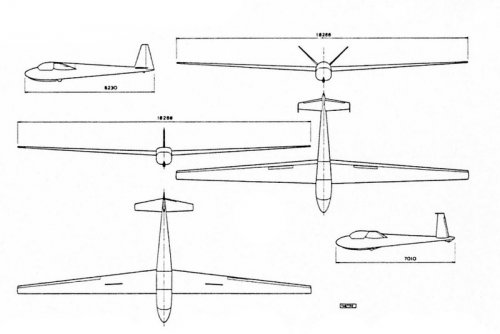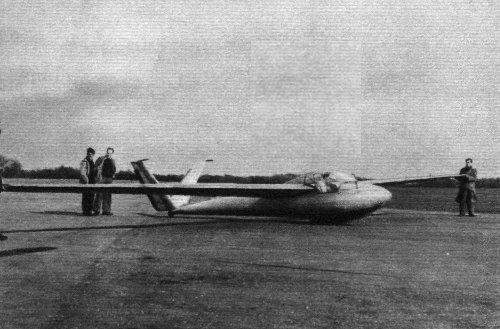- Joined
- 1 May 2007
- Messages
- 2,530
- Reaction score
- 1,734
KENDALL CRABPOT and K.1
The initial version of this sailplane, known as the Crabpot, was designed by
H. Kendall for the 1947 B.G.A. Two-seat Sailplane Competition.
Conventional wooden construction, apart from the wing which had several spanwise
webs and few ribs. The webs were 15 mm. thick, and the ribs were spaced at
from 900 to 1200 mm. pitch.
Wing span: 18.3 m., 60' 0”. Length: 8-24 rn., 27' 0”.
Wing area: 18.58 sq.m., 200 sq.ft. Aspect ratio: 18.
Wing section: NACA 43018 at root, NACA 43012A at tip.
Cantilever wing, no flaps but airbrakes were fitted. All moving tailplane.
Weights: Tare 232 kg., 516 lbs. A.U.W. 414 kg., 911 lbs.
Wing loading." 21.0 kg./sq.m., 4.3 lbs./sqft.
Max L/D: 27 at 77 km/hr., 49 m.p.h.
Project only, was the winner of the competition.
Having won the competition, the Crabpot was redesigned. The wing
section was altered, a "V" tail introduced, and the fuselage shortened. The
wing material was altered and it was decided to manufacture it using an
asbestos reinforced low pressure thermo setting plastic structure, a method
that involved the use of heated concrete moulds and tailored felts. The wing
was manufactured by F. G. Miles Ltd. at Redhill Aerodrome, under the
designation Miles M.76, but, when tested, it broke up at a fraction of the design
load.
The K.1, as the Crabpot was by then known, was later built, using the
traditional wooden construction methods, by Elliotts of Newbury, as the
Eon Type 9.
Dimensions as the Crabpot, except:
Overall length: 7.01 m., 23' 0”. Full span ailerons.
Wing sections : NACA 66,3,418 at root, NACA 64.23415 at the tip.
Weights: Tare 300 kg., 661.5 lbs. A.U.W. 453.6 kg., 1000 lbs.
Speeds: Max. 200 km./h., 125 m.p.h. Stall, 64 km./h.. 40 m.p.h.
Max. L/D: 35.
One only built, the first flight being at Lasham in March, 1954. No C. of A.
was issued as the K.1 was abandoned due to unsatisfactory flying characteristics,
particularly unsolvable spinning problems.
See also :- https://en.wikipedia.org/wiki/Miles_M.76
Source 'British Sailplanes and Gliders', N.H.Ellison, 1970, pp.138-9
cheers,
Robin.
The initial version of this sailplane, known as the Crabpot, was designed by
H. Kendall for the 1947 B.G.A. Two-seat Sailplane Competition.
Conventional wooden construction, apart from the wing which had several spanwise
webs and few ribs. The webs were 15 mm. thick, and the ribs were spaced at
from 900 to 1200 mm. pitch.
Wing span: 18.3 m., 60' 0”. Length: 8-24 rn., 27' 0”.
Wing area: 18.58 sq.m., 200 sq.ft. Aspect ratio: 18.
Wing section: NACA 43018 at root, NACA 43012A at tip.
Cantilever wing, no flaps but airbrakes were fitted. All moving tailplane.
Weights: Tare 232 kg., 516 lbs. A.U.W. 414 kg., 911 lbs.
Wing loading." 21.0 kg./sq.m., 4.3 lbs./sqft.
Max L/D: 27 at 77 km/hr., 49 m.p.h.
Project only, was the winner of the competition.
Having won the competition, the Crabpot was redesigned. The wing
section was altered, a "V" tail introduced, and the fuselage shortened. The
wing material was altered and it was decided to manufacture it using an
asbestos reinforced low pressure thermo setting plastic structure, a method
that involved the use of heated concrete moulds and tailored felts. The wing
was manufactured by F. G. Miles Ltd. at Redhill Aerodrome, under the
designation Miles M.76, but, when tested, it broke up at a fraction of the design
load.
The K.1, as the Crabpot was by then known, was later built, using the
traditional wooden construction methods, by Elliotts of Newbury, as the
Eon Type 9.
Dimensions as the Crabpot, except:
Overall length: 7.01 m., 23' 0”. Full span ailerons.
Wing sections : NACA 66,3,418 at root, NACA 64.23415 at the tip.
Weights: Tare 300 kg., 661.5 lbs. A.U.W. 453.6 kg., 1000 lbs.
Speeds: Max. 200 km./h., 125 m.p.h. Stall, 64 km./h.. 40 m.p.h.
Max. L/D: 35.
One only built, the first flight being at Lasham in March, 1954. No C. of A.
was issued as the K.1 was abandoned due to unsatisfactory flying characteristics,
particularly unsolvable spinning problems.
See also :- https://en.wikipedia.org/wiki/Miles_M.76
Source 'British Sailplanes and Gliders', N.H.Ellison, 1970, pp.138-9
cheers,
Robin.
Attachments
Last edited:



